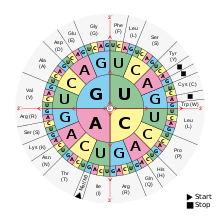Quaternary
As quaternary ( latin : quaternī , "the four") is referred to objects or structures consisting of four consist parts and composed of these elements or may be broken down into them. Linguistically related are unary (1), binary (2), ternary (3), quaternary (4), quinary (5), senary (6) and denary (10).
An example of the storage of information in a quaternary system is the coding of proteins by the four nucleotides adenine (A), cytosine (C), guanine (G) and uracil (U) in ribonucleic acid (RNA). In coding, a word or codon comprises three nucleotides and can thus assume from AAAup to UUU64 (or 4 3 ) states. The coding in the DNA is structured similarly, with thymine taking the place of uracil.
A quaternary number system was used, for example, by the Chumash people .
| Quaternary | 0 | 1 | 2 | 3 | 10 | 11 | 12 | 13 | 20th | 21st | 22nd | 23 | 30th | 31 | 32 | 33 | 100 |
|---|---|---|---|---|---|---|---|---|---|---|---|---|---|---|---|---|---|
| Binary | 0 | 1 | 10 | 11 | 100 | 101 | 110 | 111 | 1000 | 1001 | 1010 | 1011 | 1100 | 1101 | 1110 | 1111 | 10,000 |
| Decimal | 0 | 1 | 2 | 3 | 4th | 5 | 6th | 7th | 8th | 9 | 10 | 11 | 12 | 13 | 14th | 15th | 16 |
Quaternions are hypercomplex numbers with a 4-component number structure which u. a. are used in the calculations of four-dimensional space - time in the special theory of relativity .
See also
- Place value system
- Unary system (1)
- Dual system (2)
- Ternary system (3)
- Quinary (5)
- Senary (6)
- Decimal system (10)
- Hexadecimal system (16)
Individual evidence
- ↑ Madison S. Beeler: Chumashan Numerals , in Native American Mathematics , ed. by Michael P. Closs (1986), ISBN 0-292-75531-7 .
